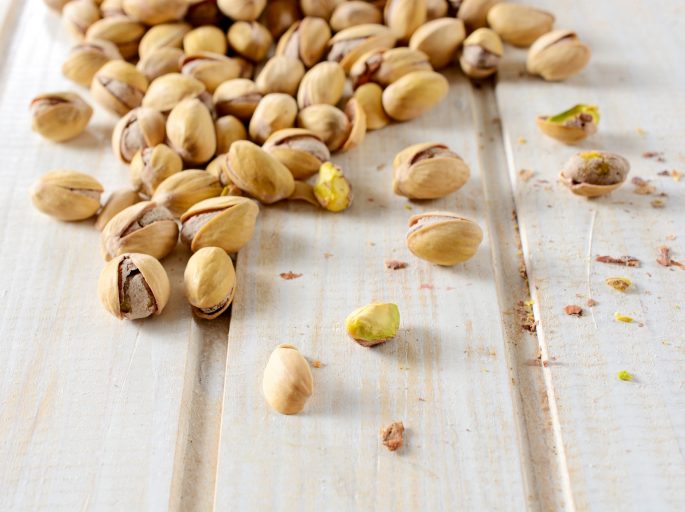Pistachio: it’s a funny little snack with a nutty name and an even funnier color. Related to the cashew – whose name really does sound like a sneeze – the word pistachio sounds more like someone trying to smother a sneeze and failing.

Pistachios are also green. Not just a little green, like ripening fruit, but the intense green of spring grass, especially when grown in cooler climates. They are, in fact, the only nut that is. Before you conclude that the color is another joke by Mother Nature, you should know that pistachios are not really nuts. They’re seeds, even though they grow on flowering trees like almonds, walnuts, and Brazil nuts. Furthermore, they are drupes, and that’s sort of what they do, in bunches, before harvest.
The pistachio’s coloring comes from chlorophyll, the essential ingredient that plants use to convert sunlight into the sugar compounds that provide energy for growth. Pistachios are champions at this. In fact, they are so efficient that much of the chlorophyll, and sugar, remains in the seed, making it both healthy and deliciously sweet.
Pistachios thrive in the high desert/temperate climate of Arizona’s Sonoran Desert, in the southwest quarter of the state. The thin, rocky soil and scarce rainfall can produce 20-foot tall trees that yield an abundance of seeds from crimson or red flower bracts. If Arizona’s soil is actually good for them, the state’s persistent sunshine only makes them sweeter, delivering some of the most nutritious and flavorful pistachios in the United States!
One of only two nuts mentioned in the Bible (the other is an almond), the pistachio is native to ancient Persia, where a single, 700-year old tree still survives as proof of the species’ hardiness. In fact, based on archeological remains in Turkey, researchers suspect that humans were harvesting and eating pistachio nuts as far back as 7,000 B.C.!
Pistachio trees came to the United States in 1854, but it wasn’t until the 1930s, during the Great Depression, that they were planted experimentally as another possible revenue source for California’s Central Valley.
It did not take long for Arizona growers to realize the potential windfall of pistachios, which do not like humid conditions. Jim Graham, Cochise Groves, LLC, is a member of the American Pistachio Growers Organization, and farms 200 acres of pistachios.
From these 25,000 trees, Jim and his wife, Ruth, harvest enough heart-healthy nuts to satisfy their southwestern Arizona clients, offering the little greenish seeds salted and roasted in the shell, in garlic, red, and green chile flavors, or unsalted. In fact, almost any way a pistachio lover could imagine eating them.
Consumers can also buy from Fistiki Farms Arizona Pistachios, and owner/proprietor Judy Auerbach sells through both the Tucson Farmer’s Market and online.
Related articles
- Avocado and Pistachio Ice Cream (fillyourplate.org)
- 31 Ways to Fill Your Plate with Arizona Eats (fillyourplate.org)
- Cause a Stir with these Sensational Salads (fillyourplate.org)

